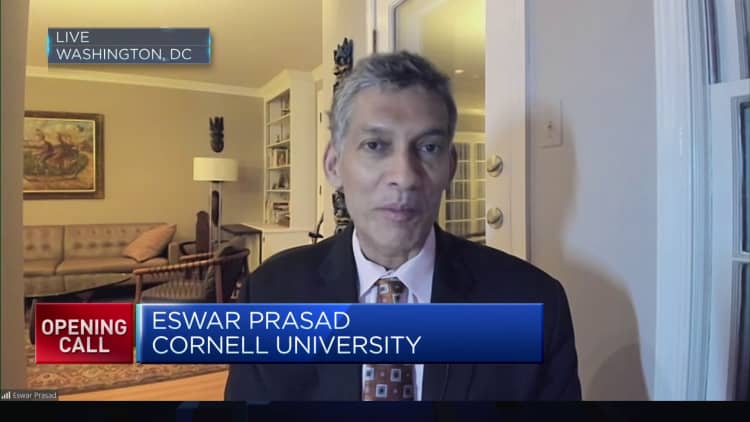[ad_1]
BEIJING — China’s consumption recovery from zero-Covid is getting off to a solid start – after a depressing fourth quarter.
When Michelin-starred restaurant Rêver reopened Thursday from a Lunar New Year break, it was fully booked, said Edward Suen, chief operating officer of the Guangzhou venue. Reservations for the next three days were near capacity, he said.
He’s hopeful business improves this year – and allows Rêver to recoup the roughly 35% in revenue it lost last year. Guangzhou city was one of the hardest hit by China’s Covid controls in late 2022, before Beijing abruptly ended most measures in early December and a wave of infections hit the country.
“Last Christmas, it was the first time in three years we didn’t run a full house, because quite a lot of people made reservations but then they got infected,” Suen said. He co-founded Rêver in June 2020.
In a down-to-earth Chinese city known worldwide for its Cantonese cuisine, Rêver is exploring a new market by serving modern French cuisine, with a multi-course dinner priced at 1,280 yuan ($183) or 1,680 yuan.
For the year ahead, “we try to be a little bit conservative on how things go,” Suen said. “Because everything’s changed so fast and so sudden in these days.”

In 2022, China saw one of its slowest years of economic growth in decades. Within a retail sales slump of 0.2% to 43.97 trillion yuan ($6.28 trillion), catering sales dropped by a steeper 6.3%.
More recent data show Chinese consumers are starting to open their wallets again, especially for travel.
During the seven-day Lunar New Year holiday that ended Friday, national tourism revenue surged by 30% from last year to 375.84 billion yuan, according to official figures. But that was still short of 2019 spending.
“Consumer sentiment is better. Spending power is kind of back,” Ashley Dudarenok, founder of China digital consultancy ChoZan, said Friday. “But I don’t think that suddenly from one month to the next things are back … to 2019 or double 2019.”
Dudarenok said that heading into 2023 and the Lunar New Year, some smaller brands had turned more conservative on China and cut their marketing budgets for the country in half.
“Consumer sentiment was really down, nobody knew what was actually coming, and a lot of marketing budget and dollars went into 11.11 [Singles Day] and it was also not successful, so brands did not earn a lot over 11.11” and another shopping festival in December, she said. “Then suddenly China opened. Many people did not expect that [and were] quite startled by this swift development.”
Dudarenok does expect overall consumer trends to continue, whether it’s people in larger cities spending more “on feeling better” or people in smaller cities paying for higher-quality products.
Many analysts expect high levels of savings among Chinese consumers during the pandemic will translate to greater spending this year.
At the policymaker level, Chinese authorities say they’re prioritizing consumption. Premier Li Keqiang led the first post-holiday executive meeting of the State Council on Saturday, and “called for efforts to expedite consumption recovery and keep foreign trade and investment stable,” according to a readout. The meeting said policies to promote the consumption of cars and other big-ticket items would be “fully implemented.”
However, unlike the U.S., China has not distributed cash to consumers nationwide in the wake of the pandemic. Li told reporters in 2022 that policymakers would instead focus on supporting businesses and jobs.
“We believe that the most important factor influencing the consumption is the outlook on future income which ties to many factors,” Hao Zhou, chief economist at Guotai Junan International, said in a note. “That being said, the reduced policy and virus uncertainties will definitely help improve the sentiment.”
He expects 7% year-on-year growth in retail sales.
Hainan’s recovery plans
Hainan, a tropical province aiming to be a duty free shopping destination, announced a goal for 10% growth in retail sales this year. That’s after its retail sales fell by 9.2% last year.
The island’s 12 duty-free stores saw gross sales of 2.57 billion yuan during the Lunar New Year holiday week, according to the local commerce department.
Those holiday sales were more than four times what they were in 2019, the release said, reflecting the region’s growth and new mall openings over the last few years.
LVMH and Coach-parent Tapestry both signed deals in 2022 with local authorities to expand their business in Hainan, including the establishment of Tapestry’s China travel retail headquarters, according to government announcements. The two companies did not immediately respond to a CNBC request for comment.
Top executives from U.S. and European brands, among others, plan to visit Hainan this year now that Covid restrictions are relaxed, said Ruslan Tulenov, global media officer for Hainan’s Bureau of International Economic Development. He declined to say how many or when.
“Before I personally I had some few discussions with some top companies last year or two years ago, but at that time [there were] some Covid restrictions, difficulties coming to China,” he said. “Some companies, they even would like to take their private jets to fly to Hainan directly, but at that time there were some Covid restrictions.”
New trends, changing fast
Brands in China have to adjust to changes not only in the Covid situation but also in the market.
Companies are moving more marketing dollars to ByteDance’s Douyin, the local version of TikTok, and away from Weibo, Dudarenok said.
While those brands were on Douyin for years, they were not part of the social conversation on the highly popular app, she said. For brands, she said the thinking now is that “China has changed, most important China has opened, and to get into that business we need to be part of that conversation.”
[ad_2]
Source link
